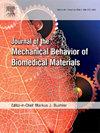Bouligand 结构中的塑性应变定位。
IF 3.3
2区 医学
Q2 ENGINEERING, BIOMEDICAL
Journal of the Mechanical Behavior of Biomedical Materials
Pub Date : 2024-11-09
DOI:10.1016/j.jmbbm.2024.106811
引用次数: 0
摘要
Bouligand 结构代表了排列整齐的纤维的螺旋形堆叠;这种结构在生物复合材料中被广泛观察到。尽管在表征 Bouligand 纤维排列引起的增韧方面取得了进展,但这种结构的非弹性变形机制仍然难以捉摸。在本研究中,我们对 Bouligand 结构、交叉层状结构和单层状结构的塑性变形进行了计算。研究发现,单层结构和交叉层状结构会出现缩颈现象,而 Bouligand 结构则会出现塑性应变定位带,并伴随纤维塑性旋转、层状扭转和层状分层。与交叉层状结构相比,Bouligand 结构的塑性能量耗散较低。然而,布里甘德模式能激活薄片的分层,产生高水平的损伤能量耗散。Bouligand 结构的塑性变形取决于相邻薄片之间界面的断裂特性。研究发现,布里甘德结构的塑性耗散随薄片界面内聚强度的增加而增加,在薄片界面较弱的情况下会出现主要的剪切带。薄片界面的高强度在促进薄片扭转方面发挥了作用。我们进一步揭示了单个薄片厚度对布利甘结构塑性变形的影响。厚薄片能够抑制 Bouligand 结构中的塑性应变局部化,从而产生高塑性耗散。本研究的发现为开发生物启发的布利甘型材料提供了新的思路。本文章由计算机程序翻译,如有差异,请以英文原文为准。
Plastic strain localization in Bouligand structures
The Bouligand structure represents helicoidal stacking of aligned fibers; such a structure is widely observed in biological composites. Despite the progress in characterization of toughening caused by Bouligand arrangement of fibers, the inelastic deformation mechanisms of this structure remain elusive. In this study, we carry out calculations for plastic deformation of Bouligand structure, crossed-lamellar structure and the single lamellar structure. It is found that the single lamellar structure and crossed-lamellar structure can undergo necking, while in the Bouligand structure, plastic strain localization bands develop, which is accompanied by plastic rotating of fibers, lamellar twisting and lamellar delamination. Compared with crossed-lamellar structure, the Bouligand structure exhibits lower plastic energy dissipation. However, the Bouligand pattern can activate delamination of lamellae, generating high level of damage energy dissipation. The plastic deformation of Bouligand structure depends on the fracture properties of interface between adjacent lamellae. It is identified that the plastic dissipation of Bouligand structure increases with increasing cohesive strength of lamellar interface, and dominant shear bands emerge in the case of weak lamellar interface. The high strength of lamellar interface plays a role in promoting twisting of lamellae. We have further revealed the effect of the thickness of individual lamella on plastic deformation of the Bouligand structure. The thick lamella is capable of suppressing plastic strain localization in Bouligand structure, thereby giving rise to high plastic dissipation. The findings of this study shed new light on the development of bioinspired Bouligand-type materials.
求助全文
通过发布文献求助,成功后即可免费获取论文全文。
去求助
来源期刊

Journal of the Mechanical Behavior of Biomedical Materials
工程技术-材料科学:生物材料
CiteScore
7.20
自引率
7.70%
发文量
505
审稿时长
46 days
期刊介绍:
The Journal of the Mechanical Behavior of Biomedical Materials is concerned with the mechanical deformation, damage and failure under applied forces, of biological material (at the tissue, cellular and molecular levels) and of biomaterials, i.e. those materials which are designed to mimic or replace biological materials.
The primary focus of the journal is the synthesis of materials science, biology, and medical and dental science. Reports of fundamental scientific investigations are welcome, as are articles concerned with the practical application of materials in medical devices. Both experimental and theoretical work is of interest; theoretical papers will normally include comparison of predictions with experimental data, though we recognize that this may not always be appropriate. The journal also publishes technical notes concerned with emerging experimental or theoretical techniques, letters to the editor and, by invitation, review articles and papers describing existing techniques for the benefit of an interdisciplinary readership.
 求助内容:
求助内容: 应助结果提醒方式:
应助结果提醒方式:


